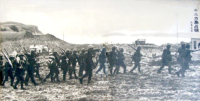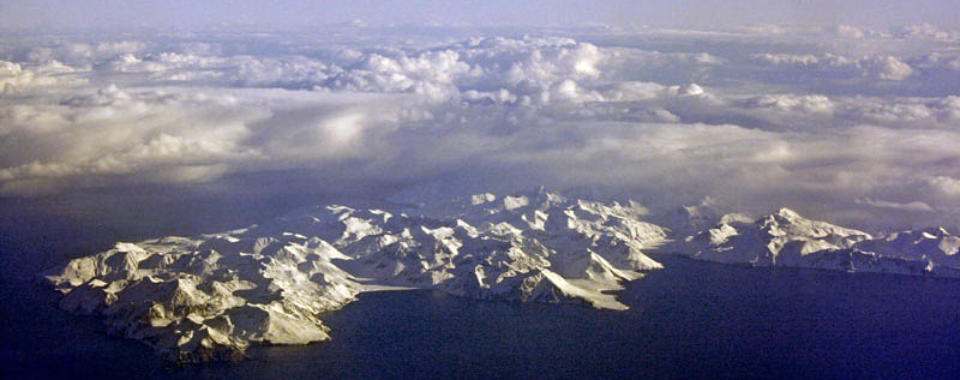
Photo By Kare Lohse
THE JAPANESE OCCUPATION OF ATTU
“7 June 1942 - 29 May 1943”



These photos were taken of those serving in the Japanese military occupying Attu, Aleutian Islands, AK as well as a
few taken on Kiska during WWII. These photos were supplied by Jill Holmgren of Anchorage, AK, a frequent
contributor to our web site; by Ian Beaton, author of the book “They Also Served,” and from other miscellaneous
sources, with translations provided by Naomi Tabuchi of Japan, Miho Lillard and Chizuko Lund.
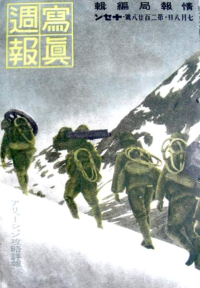
![J. Rene "Frenchy" Thibault standing by the Guard Shack's door, Attu 1946. [Rene Thibault]](index_htm_files/234268.jpg)
![J. Rene "Frenchy" Thibault standing by the Guard Shack's door, Attu 1946. [Rene Thibault]](index_htm_files/234269.jpg)
1. Naomi Tabuchi was kind enough to provide translation for this page as follows:
The title of the magazine (the yellow print) is "Shashin Shuho," meaning
"Photographs Weekly Bulletin." Additionally, "10 sen is the price of the magazine.
It is dated the 8th of July [1942], about one month after the Japanese captured
Attu. It is magazine number 2028, published by "The Information Board Editing
Station."

![Time-warping Rene Thibault from 1946 to 1995 Attu! Nadine Smith]](index_htm_files/234270.jpg)
![Time-warping Rene Thibault from 1946 to 1995 Attu! Nadine Smith]](index_htm_files/234271.jpg)
2. Naomi also translated this page for us as follows: "To a snowy dense fog zone.
Aleutians capture detailed report." This page reported about the state of the
warships sailing to the Aleutian Islands.
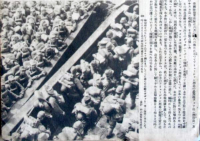
![Interior view of the Marine Brig, Attu 1946. [Rene Thibault]](index_htm_files/234272.jpg)
![Interior view of the Marine Brig, Attu 1946. [Rene Thibault]](index_htm_files/234273.jpg)
3. Naomi translated this page as follows: 7th - 8th of June [1942], Empire Army
occupies most west end Attu Island and Kiska Island of Aleutian Islands by
surprise attack. This page explained the success of the Japanese Army. The
photo is titled "Landing Japanese military unit went ashore." [Old Japanese
letters used here. Additional work being done to translate.]
6. No caption provided. Appears to be the Japanese military’s command section
overlooking Massacre Bay from surrounding high ground after capturing Attu
Village at Chichagof Harbor during their initial invasion stages.
11. No caption provided. The Imperial Japanese Navy made extensive use of their
long range flying boats in WW II. Their long range master was the Kawanishi H8K
Type 2, a high performance, four-engined bomber, reconnaissance and transport
aircraft code named "Emily" by the Allies. This was the best flying boat of the war
with excellent performance, long range and good defensive armament. Emilys
ranged the Pacific, providing valuable information about Allied movements and
dispositions. They were also employed as long range bombers and Type 2 flying
boats raided Honolulu, Hawaii in March 1942. Because of their long range, they were pressed into service as
scouts for Japanese carrier striking forces, but they often suffered grievous losses at the hands of radar
directed carrier-borne fighters when they approached U.S. task forces. (Ref. Chuckhawks.com)
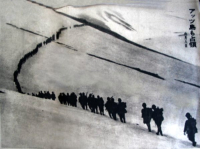
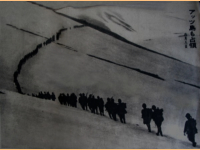

5. June 8th, 1942. The Japanese Army moves their soldiers from Chichagof
Harbor, Attu, into the mountains to build and maintain defensive positions prior
to the invasion of Attu in May, 1943. Click HERE for translation (Miho Lillard
provided translation. Our thanks!).
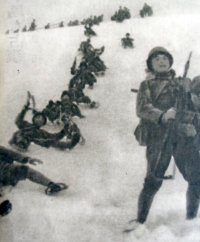
![L-R: Thornberg, Velasco, and Jones. [Rene Thibault]](index_htm_files/234276.jpg)
![L-R: Thornberg, Velasco, and Jones. [Rene Thibault]](index_htm_files/234277.jpg)
7. No caption provided. These Japanese soldiers appear to be continuing their
march from Attu Village to set up defensive positions in the mountainous areas
surrounding Massacre Bay prior to the Allied invasion in May, 1943.
4. June, 1942. Translated by Miho Lillard and Chizuko Lund: "The families of the
guards (defense?) in Chichagofu (Titchagov?) came out hands up, shaking with
fear, but they soon got back peace in their mind because of the imperial army’s
(troops or military) warm treatment towards them. First children smiles, then
mothers smiled." [Etta Jones, teacher, nurse, and surviving spouse of Foster
Jones, can be seen in the foreground]
8. No caption provided. Japanese troops moving a machine gun on a sled to a
defensive position in the mountainous areas around Massacre Bay.

This first group of photos, provided by Jill Holmgren of Fairbanks, AK, came from a WWII-era Japanese photo
magazine containing stories of the Japanese military in the Aleutians beginning June 6th, 1942. The lack of
sharpness and other image quality issues are a result of these photos having been extracted from old newspaper
media. Originally published 26 August 2005:
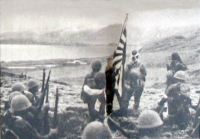
![Attu's South Barracks, 1946. [Rene Thibault]](index_htm_files/234278.jpg)
![Attu's South Barracks, 1946. [Rene Thibault]](index_htm_files/234279.jpg)
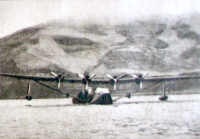

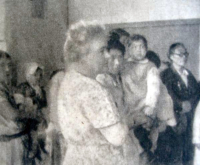

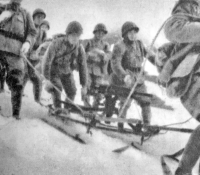

9. No caption provided. Japanese troops taking a break, preparing and eating a
meal, and catching up with a little reading before digging in.
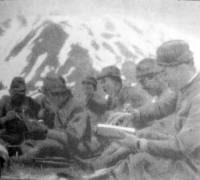

10. No caption provided. Japanese troops appear to be setting up defensive
positions on a barely accessible high point in the mountains surrounding
Massacre Bay prior to the Allied invasion in May, 1943.
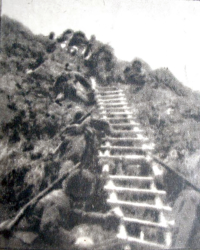

Ian Beaton ("They Also Serve") Ian arrived on Shemya Island in November 1943, and stayed through July 1945. While
on Shemya, Ian had a friend who had access to the Shemya Air Base Photo Lab. His friend found a roll of film that
had belonged to a Japanese soldier stationed on Attu. The Japanese soldier to whom the film belonged was more
than likely killed in the Battle for Attu some time during May of 1943, as there were only 28 surviving Japanese
soldiers. There's no evidence the film belonged to any of these 28 survivors. Ian had prints made from this roll of
negative film in 1943, with the U.S. Army censor's stamp on the back of each photo. Ian sent these photos home to
his family in 1944. For several years Ian has been trying to get these photos to the surviving families of the soldiers
seen in these photos. In August of 2003, Ian's story along with two of the photos appeared in "The Yomiuri
Shimbun," one of the largest newspapers in Japan, with no results. Ian was kind enough to allow us to publish
these photos on our web site, with hopes that perhaps someone in Japan or elsewhere will recognize the soldiers in
these photos. These photos were taken on Attu sometime between June 6th of 1942 and May 10th of 1943, when
Attu was re-captured by the Allies from the Japanese. The following photos were supplied to us by Ian Beaton,
Originally published 30 August 2005:
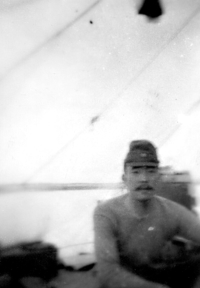
![J. Rene "Frenchy" Thibault standing by the Guard Shack's door, Attu 1946. [Rene Thibault]](index_htm_files/234285.jpg)
![J. Rene "Frenchy" Thibault standing by the Guard Shack's door, Attu 1946. [Rene Thibault]](index_htm_files/234286.jpg)
1. As we don't know who is in these photos or exactly what's going on, I will
provide my best guess as to what we're seeing. This photo appears to be of an
individual, perhaps an officer, inside a tent. Could be an office or sleeping tent.
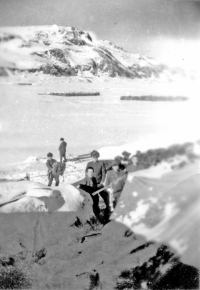
![Time-warping Rene Thibault from 1946 to 1995 Attu! Nadine Smith]](index_htm_files/234287.jpg)
![Time-warping Rene Thibault from 1946 to 1995 Attu! Nadine Smith]](index_htm_files/234288.jpg)
2. It appears that perhaps the soldiers were digging in, preparing defensive
positions in the mountains of Attu. As there is an adequate amount of snow on the
ground, the date for this photo would be somewhere between October of 1942 and
April of 1943.
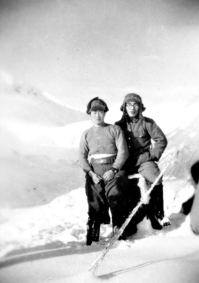
![Interior view of the Marine Brig, Attu 1946. [Rene Thibault]](index_htm_files/234289.jpg)
![Interior view of the Marine Brig, Attu 1946. [Rene Thibault]](index_htm_files/234290.jpg)
3. This photo appears to be that of two enlisted Japanese soldiers, buddies no
doubt, posing in front of a tent on one of Attu's mountains. There were
numerous defensive positions set up by the Japanese overlooking Massacre Bay,
which may be the location of this encampment. The Japanese had 11 months to
get their defenses established prior to the invasion of Attu by the Allied Forces
in May of 1943.
6. Enjoying a bit of fun in out in the winter sun while it lasts. Winter will turn to
spring, and May 1943 will bring a different life style to their everyday existence.
Soon they will be living in underground shelters, eventually running out of
ammunition and food…reduced to having eaten thistles to survive. They would
all but 28 of the 2,000+ soldiers initially occupying Attu pay the price of a futile
existence at their commander’s direction to hold the island, a deed many
thought was to protect their homeland from invasion by the Allies as opposed to
the plan of invading the North American continent.
11. And finally, who could envision while looking at this beautiful mountain
scenery the terrible battle that would begin on the 11th and end on the 29th of
May of 1943, 11 months after the Japanese initial occupation of Attu? The ensuing
battle resulted in 549 American KIA with another 1,148 wounded, and yet another
2,100 evacuated from Attu the result of disease or climate-related injuries (trench
foot, frostbite, etc.). The Japanese suffered 2,850+ KIA with either 28 or 29 having
been captured alive…not an outcome desired by the Bushida code.
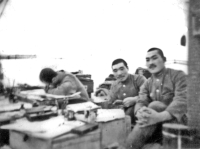
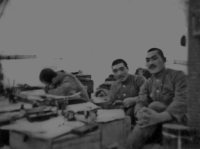

5. Apparently this photo was taken in an office environment. The illumination
from the background was the sun shining on that side of the tent. These
individuals appear to be middle-level management officers or NCOs.
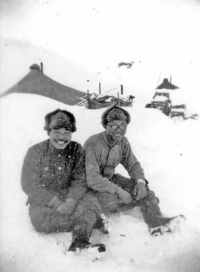
![L-R: Thornberg, Velasco, and Jones. [Rene Thibault]](index_htm_files/234293.jpg)
![L-R: Thornberg, Velasco, and Jones. [Rene Thibault]](index_htm_files/234294.jpg)
7. Lifetime friendships are forged between individuals while serving in the
military, especially between those either facing or engaged in battle. These two
were obvious friends, enjoying Attu's winter wonderland adventure prior to the
Battle of Attu.
4. I'm guessing that this photo is one of several of the ranking officers on Attu
due to the uniforms being worn. Also...nice quarters!
8. Could be this group of soldiers were discussing defensive positions and
strategy in and around the mountainous regions of Attu overlooking Massacre
Bay.
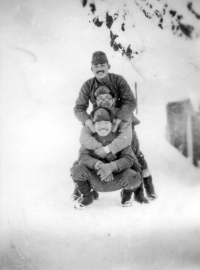
![Attu's South Barracks, 1946. [Rene Thibault]](index_htm_files/234295.jpg)
![Attu's South Barracks, 1946. [Rene Thibault]](index_htm_files/234296.jpg)
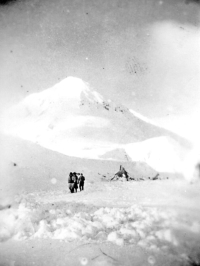

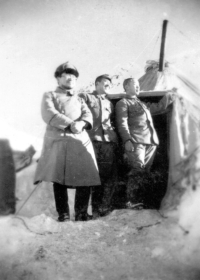

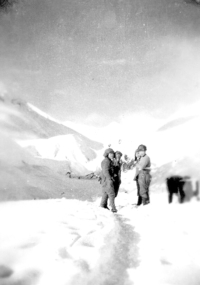

9. There are always those who know how to make the best of any situation.
Here's a lad that brought his skis along with him on his assignment to Attu. This
indicates that it was not all work and no play during the Japanese Army's 11-
month long deployment to and occupation of Attu. [Note: photos seen in Attu’s
Scrapbook section shows American GIs on skis. A possibility it was that these
skis eventually ended up in their possession.]
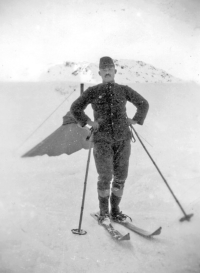

10. I believe this is a picture of a different skier, but I'd be willing to bet it's the
same pair of skis!
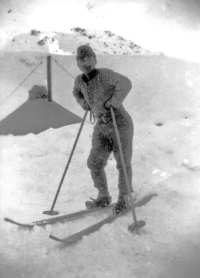

12. The remains of battle: a Japanese 75mm Gun on Attu. [Originally published 26
Nov 2006, George & Nadine Smith]
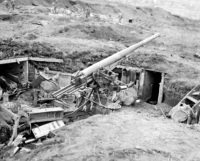

Miscellaneous photos collected from various sources over the years
14. Two of the 10 captured U.S. Navy sailors on Kiska. [Originally published 26 Aug
2005, George & Nadine Smith]
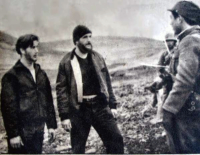

13. Kiska occupation, June 7th,1942. [Originally posted 26 Aug 2005, George &
Nadine Smith]
